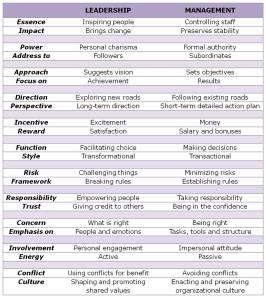The purpose of this post is to compare and contrast the concepts of leadership and management and to discuss best management and leadership styles.
What is the difference between management and leadership? There are multiple definitions of both terms elaborated by scholars in an attempt to differentiate the two.
The godfather of modern management Peter Drucker suggested “management is about human beings. Its task is to make people capable of joint performance, to make their strengths effective and their weaknesses irrelevant” (2006: 194). But this definition seems to be equally suitable for both management and leadership. So, where hides the difference?
Management concept
A number of interpretations from classical management theories to revolutionary ideas have been expressed on management, but the common feature of all approaches is its functional character. Thus, Fayol (1949: 5) defines management through its 5 key functional components; similarly, Drucker (1977: 28) identifies 5 operations of management; and Brech (1975:19) sees 4 management elements. Furthermore, all approaches clearly share common elements.
Henry Fayol’s model:
Peter Drucker’s model:
Edward Brech’s model:
A concise summarising definition of management is formulated by Mullins claiming that management is “getting work done through the efforts of other people” (2013: 421).
Leadership concept
According to Yukl leadership is a “process of influencing others” and “facilitating individual and collective efforts to accomplish shared objectives” (2010: 26). The key idea of the notion is the ability to impress, inspire and influence people so that they want to contribute their efforts to common achievement.

Leadership is unimaginable without followers – “there is no leader without at least one follower” (Kellerman 2007: 84). But why should people follow? The only reason is because they get satisfaction through achieving personal goals. A successful leader attracts followers by integrating 3 areas of needs: group, task and individual needs (Adair 1979: 10).
The relationship between leadership and management
The two concepts are “radically different” argues Kotler (2013), but both are crucially important for organizations. The full range of differences is summarized in the table:
In general, it appears that leadership and management exist in different dimensions. Leadership is a personality feature, either an inborn trait or a developed skill. Management is only about job role, it is entirely formal; it is more about the characteristic of one’s hierarchical position at work. Management is not a personality attribute. “There is a clear implication that leadership is not a part of the job but a quality that can be brought to the job” (Belbin 1997: 98).
You might be a natural leader, but not occupy a manager’s position in the company where you work; you can be a good manager but do not have leadership skills; or you can have both leadership ability and formal management authority and use your leadership skills to manage your subordinates. In one person leadership and management might overlap, coincide or even be detached.
Consider examples of each case:

- Elvis Presley – the legendary king of Rock-and-Roll – is a perfect example of a true leader, but not a manager. What makes him leader? Followers. Elvis had and his legacy still has millions of followers all over the world. What else? Mission. A real leader is to inspire people. And Presley’s music and lyrics are inspiring and motivating. His songs were and continue to be the driving force of human imagination. Yet, he never had subordinates to manage and was not manager.
 A great management success without leadership can be illustrated by the example of Michelle Miller – the Walgreen’s store manager in California. Michelle achieved exceptional results in personnel management by using purely management technique – she recognized individual strengths of her employees and found the way to rearrange job roles in a highly effective and beneficial way. But she was not leading her subordinates; she only created a formal framework, i.e. purely managed them by setting responsibilities, shifts, schedules, promotions, etc. (Buckingham 2005)
A great management success without leadership can be illustrated by the example of Michelle Miller – the Walgreen’s store manager in California. Michelle achieved exceptional results in personnel management by using purely management technique – she recognized individual strengths of her employees and found the way to rearrange job roles in a highly effective and beneficial way. But she was not leading her subordinates; she only created a formal framework, i.e. purely managed them by setting responsibilities, shifts, schedules, promotions, etc. (Buckingham 2005) Probably, one of the most commonly referred to examples of the combination of leadership and management (particularly interesting in the context of the IT industry explored throughout the entire blog) is the example of Steve Jobs, who was not only a CEO of Apple, but a powerful, charismatic and creative leader inspiring his staff as well as unrelated to IT production people (Sharma and Grant 2011). What made him such an influential leader? He had vision. So, he was an inspirational or visionary leader – a variation under the transformational leadership model (Burns 1978).
Probably, one of the most commonly referred to examples of the combination of leadership and management (particularly interesting in the context of the IT industry explored throughout the entire blog) is the example of Steve Jobs, who was not only a CEO of Apple, but a powerful, charismatic and creative leader inspiring his staff as well as unrelated to IT production people (Sharma and Grant 2011). What made him such an influential leader? He had vision. So, he was an inspirational or visionary leader – a variation under the transformational leadership model (Burns 1978).
What is the most effective approach to managing the work of subordinates?
This is one of the most extensively discussed questions over the last century. The CMI report (2013) points that the general consensus has moved away from “command-and-control” towards more “facilitate-and-empower” approach (Mintzberg 2009:121), and the best approach may vary according to circumstances and individual characteristics. This seems to indicate the preference for leadership over management. Analogical view is shared by P.Drucker (1993), who sees the future of management in incorporating leadership skills into management functions.
In conclusion
It is a more than century-long debate on the differences between management and leadership. Although they are not the same, they are necessarily linked, and complementary. Moreover, “Leadership and management must go hand in hand” (The Wall Street Journal 2014).The most effective approach to management is, I believe, through the application of leadership skills.
It is also essential to remember that due to a complex human nature alongside the exposure of management to external circumstances, the management of the XXI century needs to be flexible, situational and have personal style.
***
References:
Belbin, R.M. (1997) Changing the way we work. Oxford: Butterworth-Heinemann
Brech, E.F.L. (1975) Principles and practice of management. 3rd edition. Harlow: Longman.
Buckingham, M. (2005) “What great managers do?” Harvard Business Review 83 (3) 70 – 79
Burns, J.M. (1978) Leadership. New York: Harper & Row
CMI (2013) Understanding Management Styles. Checklist 236. London: Chartered Management Institute
Drucker, P.F. (1977) People and performance. Oxford: Butterworth-Heinemann
Drucker, P.F. (1993) Managing for the Future: the 1990s and beyond. New York: Truman Talley Books/Plume
Drucker, P.F. (2006) Classic Drucker. Boston: Harward Business Press
Fayol, H. (1949) General and industrial management. London: Pitman Publishing
Kellerman, B. (2007) “What every leader needs to know about followers?” Harward Business Review 85 (12) 84 – 91
Kotler, J.P. (2013) “Management is (still) not leadership”. Harward Business Review Blog [online] 9 January, available from <http://blogs.hbr.org/2013/01/management-is-still-not-leadership/> [16 March 2014]
Mintzberg, H. (2009) Managing. Harlow: Financial Times prentice Hall
Mullins, L.J. (2013) Management and Organisational Behaviour, 10th Edition. Harlow: Pearson Higher Education
Sharma, A. and Grant, D. (2011) “Narrative, drama and charismatic leadership: The case of Apple’s Steve Jobs”. Leadership 7 (1) 3 – 26
The Wall Street Journal (2014) What is the difference between management and leadership? [online] available from <http://guides.wsj.com/management/developing-a-leadership-style/what-is-the-difference-between-management-and-leadership/> [14 March 2014]
Yukl, G. (2010) Leadership in Organizations: Global Edition, 7th Edition. Harlow: Pearson Higher Education




The table with comparison is good, but it is missing an important point that “managers do things right, but leaders do right things” (don’t actually remember who was the first to say that 😉 )
Daniel, it was Kent T.W. who proposed that. Thanks for reply